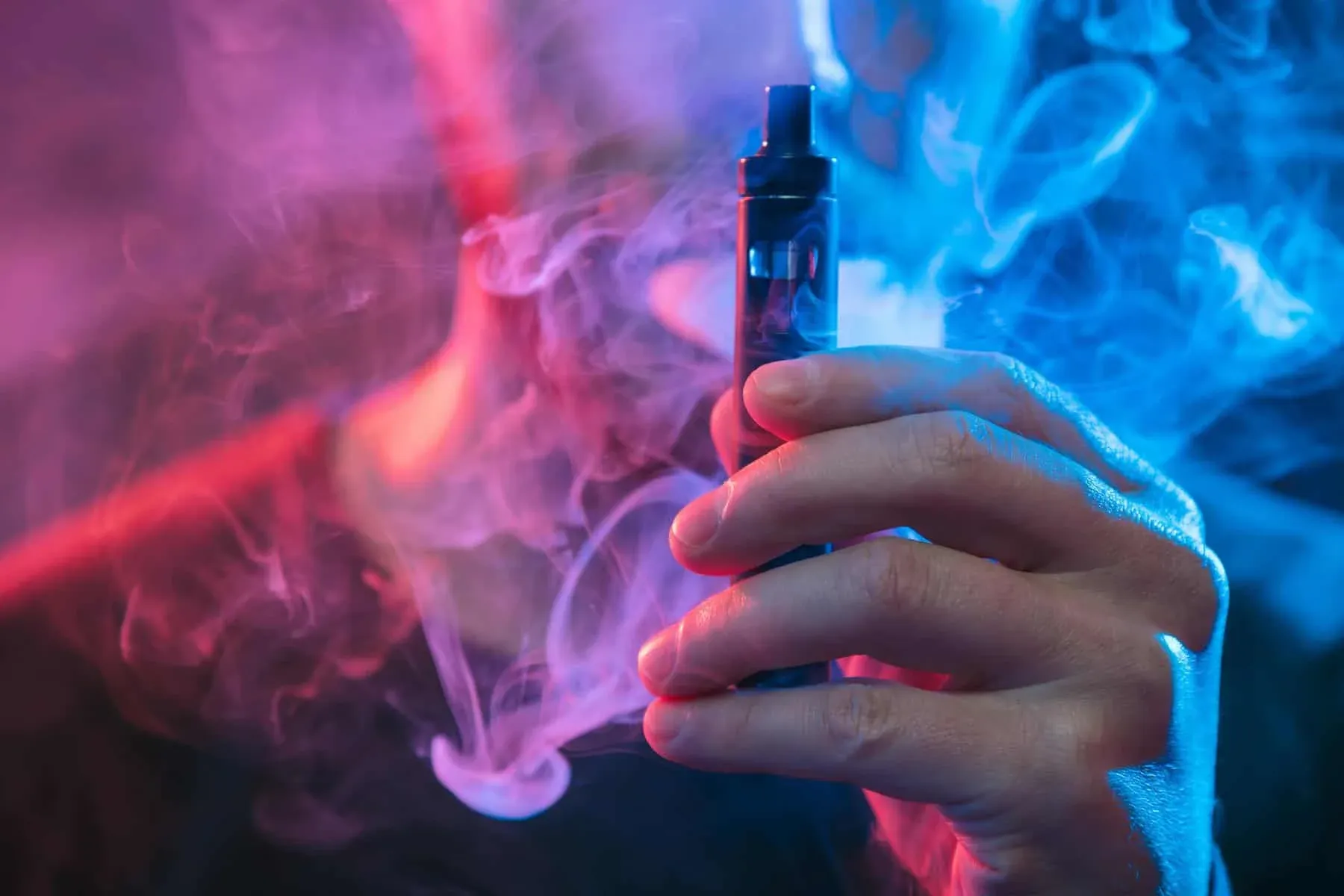While it’s true that all the medical dangers of vaping aren’t yet fully understood, there’s enough evidence to suggest many reasons not to vape. Despite a lack of comprehensive studies, a significant number of people mistakenly believe that vaping nicotine derived from tobacco is a healthy way to quit smoking. A misconception often fueled by the tobacco industry.
Reasons People Vape
People vape for various reasons, influenced by personal, social, and health-related factors:
- As an Alternative to Smoking: Many people turn to vaping as a way to quit or reduce smoking traditional cigarettes.
- Social Influence: Peer pressure or social circles where vaping is common influences individuals to start vaping. Especially, among teens and young adults.
- Curiosity and Experimentation: Curiosity often drives people, particularly younger individuals, to try vaping. The variety of flavors and the novelty of the devices can be appealing.
- Stress and Anxiety Relief: Some people use vaping as a means to cope with mental health issues like stress, anxiety, or depression, similar to how some use cigarettes or other substances like alcohol and drugs.
- Recreational Use: The recreational aspect, including the enjoyment of different flavors and the physical act of vaping, appeals to some users.
- Control Over Nicotine Intake: Vaping devices allow users to control their nicotine intake, including options with lower nicotine or no nicotine at all.
- Avoidance of Smoking Bans: In places where smoking cigarettes is banned, some people might choose to vape instead.
- Perceived as Safer: There’s a common perception, though not entirely accurate, that vaping is safer than smoking cigarettes. This perception motivates people to choose vaping over smoking.
- Weight Management: Some people use vaping as a tool for weight management, as nicotine can suppress appetite.
- Image and Lifestyle: Vaping is sometimes associated with a certain lifestyle or image that people want to be part of, influenced by marketing and social media.
It’s important to note that while vaping might be less harmful than traditional smoking, it is not without health risks. Especially, for non-smokers and young people. The long-term effects of vaping are still being studied. However, there are clear reasons not to vape.
The Misconception of Vaping as a Healthy Alternative
The perception of vaping as “harmless” seems to be known more by today’s teens and tweens than their parents. Initially promoted as a safer alternative to smoking tobacco, the popularity of vaping soared. The absence of carcinogens and tars that are usually found in conventional tobacco products painted vaping in a harmless light. The promise of no secondhand smoke was an additional selling point.
At face value, it appeared quite benign. However, these assumptions were far from accurate. Vaping isn’t just about inhaling harmless water vapor. It’s an aerosol filled with toxic particles, posing a multitude of potential risks. These risks stem from device-specific issues, the composition of the vaporized liquid products, and the potential toxicity of both nicotine and marijuana when inhaled in concentrated forms.
It’s conceivable to consider vaping as a “lesser of evils” compared to traditional cigarette smoking. But, there is a stark reality—there is still so much we do not understand about vaping. Much of our learning curve will come from reports of potential health complications linked to vaping made to the Food and Drug Administration (FDA).
Understanding the Composition of Vape Aerosols
To truly understand the dangers of vaping, it’s essential to be aware of what users are breathing in. Vaping aerosols, sometimes inappropriately referred to as ‘water vapor’, contain various potentially harmful substances. Despite containing components that are considered safe for cosmetic or food use like glycerol (vegetable glycerin) and propylene glycol (PG), their safety when inhaled long-term remains unknown.
Vaping operates by heating a liquid into an aerosol that is then inhaled into the lungs. This isn’t the harmless water vapor many think it is, but a cocktail of particles including nicotine, flavoring, and other unknown substances. These particles, suspended in air, travel from the mouthpiece of the e-cigarette into the user’s mouth, down the throat, and then into the lungs.
Scientifically published research conducted by Papaefstathiou et al. (2020) assessed the particle size distributions and volatile organic compounds exhaled by e-cigarette users. Their findings further illuminate the reality of vape aerosols and add another point to the dangers of vaping.
A common component of e-cigarettes—the element used to transform the liquid into an aerosol—is often misconceived as being as harmless as ‘water vapor’. Contrarily, it’s a combination of multiple substances, each bringing a risk factor. E-cigarettes or vape pens are powered by batteries. As it powers on, it heats the liquid to create the aerosol.
These vaping products deliver not only nicotine, proven to have not only detrimental health effects and addictive properties but also potentially other addictive substances like THC, the psychoactive component of cannabis, and illicitly, even methamphetamines. Each hit from the device draws these substances into unsuspecting lungs, unveiling the hidden dangers of vaping.
Device-Specific Issues and Potential Dangers
Vaping devices can cause mechanical injuries, burns, or even explosions, due to malfunctioning. Safety standards are set to minimize these risks, but even certified devices are not completely safe, especially when near oxygen sources where they can cause fires. Furthermore, the aerosols that come from vaping contain harmful substances like nicotine, flavoring agents, and unidentified substances, and have been associated with delivering methamphetamines and THC.
Research links vaping to diminished fractional exhaled nitric oxide (FeNO) and increased respiratory impedance, highlighting its potential health dangers. In addition, evidence linking vaping to lipoid pneumonia, a serious health condition, is mounting too. These and many other revelations have begun to erode the perception of vaping as safe. The reasons not to vape are becoming increasingly clear and compelling.
Lung and Organ Damage From Vaping
Vaping, despite commonly being perceived as a safer alternative to smoking, carries a multitude of health risks including organ damage. The chemicals not only damage the lungs but also critical organs such as the heart and brain. Further risks include a severe lung condition known as EVALI (e-cigarette or vaping product use associated lung injury), increased severity in existing respiratory conditions, and a permanent lung scarring condition called “popcorn lung” caused by a chemical named diacetyl.
In addition, the electronic nicotine delivery system (ENDS) present in these devices creates potentially harmful vapors from nicotine, flavorings, and other additives. Many are seemingly unaware of these dangers, drawing parallels to the delayed understanding of the harm cigarettes cause. The addition of these foreign substances, even as vapor, disrupts lung function and can provoke severe health complications.
The Potential for Addiction to Vaping
Vaping, while perceived as less damaging than traditional smoking, still presents significant addiction risks. Many vaping products contain nicotine, an addictive substance that can cause harm to the brain, particularly in teens and young adults. Even though certain products claim to be nicotine-free, they have been found to contain it. Even slight usage of e-cigarettes can lead to addiction.
The Most Compelling Reasons Not to Vape
To summarize, there are numerous reasons not to vape. Especially, for non-smokers, young people, and pregnant women:
- Health Risks: Vaping exposes the user to various chemicals, including nicotine, which is addictive and harms adolescent brain development. Other substances in vape juice also pose health risks.
- Addiction: Nicotine is highly addictive. Like other substances of addiction, vaping can lead to nicotine addiction. Thereby, making it hard to quit and potentially leading to the use of traditional cigarettes.
- Impact on Lung Health: Vaping has been associated with lung problems. The inhalation of certain substances in vape juice, like vitamin E acetate, has been linked to serious lung conditions.
- Gateway to Smoking: For non-smokers, especially teenagers and young adults, vaping acts as a gateway to smoking traditional cigarettes. Consequently, reversing decades of progress in tobacco control.
- Unknown Long-Term Effects: The long-term effects of vaping are still not fully understood. Vaping is relatively new, and more research is needed to understand long-term health consequences.
- Expenses: The cost of purchasing vaping devices and refill cartridges adds up.
- Social Influence and Peer Pressure: Young people, in particular, may face peer pressure to vape. Thus, leading to unhealthy habits and lifestyle choices.
- Secondhand Exposure: While less harmful than traditional cigarette smoke, the aerosol from e-cigarettes still contains chemicals that may be harmful to bystanders.
- Pregnancy Risks: Vaping during pregnancy can be harmful to the fetus. Nicotine exposure during pregnancy affects fetal brain and lung development.
- Environmental Impact: The waste from disposable e-cigarettes and cartridges contributes to environmental pollution. Many vaping products are not biodegradable or recyclable.
For these reasons, individuals, especially those who do not currently smoke, are generally advised to avoid starting vaping. Those who do vape should be aware of these risks and consider seeking help to quit.
Begin a Healthier, Happier Lifestyle at Enlightened Recovery
Enlightened Recovery Recovery helps individuals seeking a life liberated from the grasp of harmful substances. Our holistic approach goes beyond abstaining from drugs and alcohol. It’s about nurturing a healthy lifestyle that heals the mind, body, and spirit. We believe that true recovery encompasses physical well-being, mental clarity, and spiritual balance.
Contact us today to learn more about the reasons not to vape and how to get started on the path to freedom and wellness.




